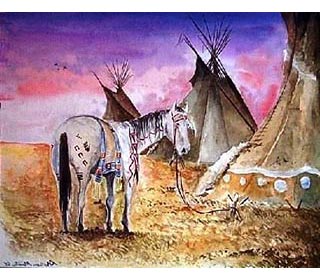The designs and symbols painted on horses were believed to hold magical powers for protection and to indicate previous victories in battle. Horse War Paint Symbols shown on the Picture
The following types of symbols can be see in the above picture depicting Horse War Paint - they represent a horse hoof print: 
The hoof print symbol has been painted on the side of the horse. Every hoof print symbolizes each animal taken on a raid.

The long zig-zag lines symbolize lightning to add power and speed to the horse. The Great Plains Indians culture abounds with many more examples of this usage of symbols. For more facts and info see Native American Symbols. Native American Warrior Culture - Horse War Paint
The Native American Indian valued their horses and held them in the highest esteem. Going into battle was dangerous for both the Native American and his horse. It therefore made sense to apply war paint to their horses as well as themselves. The achievements of warriors were often reflected in the symbolic images of their war paint. The clothes, tepees and all of his belongings, including his war horse, was decorated with the symbolism of his achievements or his various spirit guides. Every element of War Paint on the face and body of an American Native Indian had meaning. As did the symbols that decorated his Mustang horse - Horse War Paint. Reasons for applying Horse War Paint
Native American Indians applied War Paint on their Mustang horses for the following reasons: - Visual Messages: Symbols were recognised as having specific meanings like the symbols shown above. The same ritual symbols that were painted on a horse that might also be painted on the face and body of the Native Indian
- Marks of Distinction and Honor: Horse War Paint might include symbols to indicate major achievements and success
- Mental Preparation: Medicine Men often chose certain markings for warriors and that powerful magic was passed on during the application of the Horse War Paint helping the warrior to believe himself and his horse invincible
- Power and Magic: It was believed that the application of certain symbols and colors afforded the wearer with 'Magic' for power and protection by drawing on natural powers and combining these with the power of the warrior and his horse. Symbols included stripes, circles and triangles
- To recall special events: Victory, Mourning etc were indicated by the application of horse war paint.
- Following a battle: A triumphant warrior might apply paint to his horse so the tribe could see at a glance the outcome of the battle from a distance. Native American Indians prepared the paint which was then dried and stored as a powder. The paint powder was kept in deerskin pouches which could be carried with them
Horse War Paint - Making Horse War Paints
The Native Indians made Horse War Paint from the natural resources that were available to them to make different colored dyes and pigments including red clays, barks and berries, white clays and eggshells, black charcoal, yellow from flowers, plants and moss, blue from clays and duck manure and green from moss and algae. Paint in it's simplest form, consists of ground up pigment suspended in some sort of liquid, or binder such as urine, spit, egg yolks, animal fat and blood. Meaning of Horse War Paint Colors
There were so many tribes of Native American Indians it is only possible to generalise the most common meanings of the colors and patterns of Horse War Paint, Body Paint or Face Paint. - Red Color Symbolised war, blood, strength, energy and power
- Black was used to symbolize victory and might be applied to the horse before returning home to the camp
- White Color Symbolised mourning but might also mean peace
- Blue Color Symbolised wisdom and confidence
- Yellow Color Symbolised the color of death. Yellow indicated that the wearer and horse were brave and were willing to fight to the death
- Green Color Symbolised endurance, and is seen as a great healing power and believed to improve vision - green circles might be painted around the eyes of a horse
- Purple color symbolised power, mystery and magic
Horse War Paint and other Non-verbal forms of Communication
The meanings of horse war paint was just one of the forms of non-verbal communication methods used by Native American Indians. The different types of non-verbal communication methods were: - Smoke Signals
- Fire signals that were used at night
- War paint
- Native American Sign Language
- Mirrors - messages could be sent over long distances using sunlight to direct the flashes
- Piles of stones could be used to convey messages
- Picture messages on trees, skins, rocks using Native American Symbols
|

